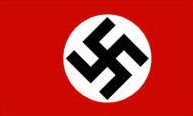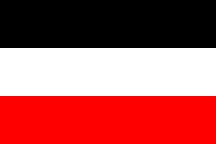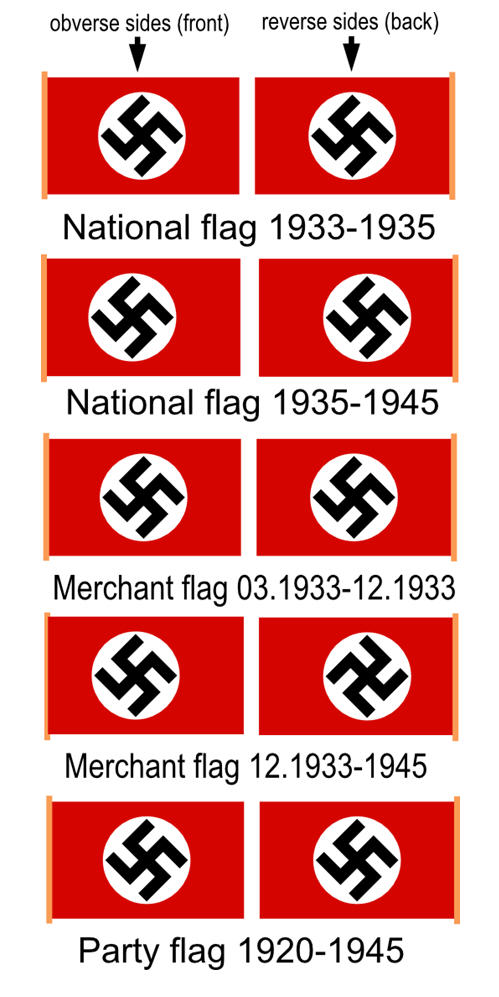Note: If an image ever fails to appear - refresh your page, it really is there
The German Swastika Flag 1933-1945
written and edited by "Fornax" and Pete Loeser
 |
|
 |
NSDAP Party Flag
(centered design) |
|
German Merchant Flag
(off-center design) |
Here are some little known facts about the German Swastika flag used by the "Third-Reich" in the years 1933-1945. Generally, there existed two designs used on three versions of the swastika flag: one design displayed the white disk, containing the swastika, in the center of the flag. A second design showed it slightly set off towards the hoist (flag pole side). Moreover, although the most common version had the swastika on both sides "right-facing," there were flags that displayed the swastika on the reverse side as a "through and through" or mirror image, so the flag had a "right-facing" swastika on the front (or obverse) side and a "left-facing" swastika on the back (or reverse) side.
One of the most common reasons given for moving the white disk containing the swastika slightly towards the hoist is to combat an optical illusion. When a flag is flying briskly, the outer half appears shorter than the half next to the staff and the centered white circle would appear to be more towards the fly. However, since this effect depends on the weather conditions and the way the flag is flying, some question this whole explanation. A poorly-made flag which exaggerates the closeness of the circle to the staff, would also completely defeat this attempt to combat the illusion.
 |
|
 |
|
 |
Reverse Side Type 1
(reversed image) |
|
Reverse Side Type 2
(reversed image) |
|
Reverse Side Type 3
(mirror image) |
The most common reason given for using the mirror image design on the reverse side is cost related. A large national flag was always sewn with double-ply (two layers) of cloth and always had the circle sewn on both sides, a more expensive process. The Handelsflagge was usually printed, not sewn, and usually was single-ply. The use of the mirror image swastika design was simply the result of using the less expensive one layer cloth material and a way of eliminating potential reverse-shadowing of the dark swastika on the white circle, especially in bright sun light. This applies also to the special merchant ensign with the Iron Cross in the canton.
Let us examine these three flags closer:
- The Party Flag (Parteiflagge)
- The National Flag (Nationalflagge)
- The Merchant Flag (Handelsflagge)
1. The Party Flag 1920-1945
 |
|
 |
The Party Flag 1920-1945
(front or obverse side) |
|
The Party Flag
(reverse side) |
The first party flags turned up in the beginning of the 1920’s. They displayed the disk and swastika in the center of the flag. The reverse side was the same as the obverse, i.e. both sides displayed a "right-facing" swastika. There was some confusion after the war about these party flags. Allied soldiers deemed these flags to be "National flags," so a lot of publications later maintained that the centered disk version was used until the end of the war. In fact, the only centered disk versions of the flag used after 1935 were on the Party flags of the NSDAP.
2. The National Flag 1933-1945
 |
|
 |
|
 |
| National Flag 1933-1935 |
|
National Flag 1933-1935 |
|
National Flag 1935-1945 |
The swastika flag as national flag was adopted on March 13, 1933, in conjunction with the Black-White-Red striped flag. The position of the disk and swastika on this first version of the national flag was centered. On September 15, 1935, the national flag was changed concerning the position of the swastika. Henceforth, the regulations demanded the disk and swastika be "slightly" set off from the center towards the flag pole. As the position was not defined very clearly by this regulation, there resulted a lot of complications as to the correct position of the swastika and circle. So it became necessary to make a very distinct regulation. On June 18, 1937, a final regulation gave precise details as for the position of the disk. From that date on it was demanded that the center of the disk be moved exactly 1/20 of the length of the flag (in relation to the center of the flag) towards the flag pole. As it turned out, even this exact definition wasn´t always followed and some variants still existed after 1937. The reverse side of the national flag was to be the same as the obverse, i.e. both sides display a "right-facing" swastika.
3. The Merchant Flag 1933-1945
 |
|
 |
|
 |
| Merchant Flag 1933-1935 |
|
Merchant Flag March-December 1933 |
|
Merchant Flag 1933-1945 |
The first Merchant flag which was introduced on March 31, 1933, was to be the same as the National flag, i.e. centered disk with swastika, both sides displayed a "right-facing" swastika. It was also used jointly with the black-white-red striped flag. However, on December 20, 1933, the Merchant flag was changed. The disk was set off "slightly" towards the flag pole. The official regulations showed the disk moved 15/75 towards the pole. The reverse side was changed to a "through and through" image, although it is not absolutely clear whether this change happened in December of 1933, or a little bit later. Until September of 1935, the off-centered version was confined to the merchant flag, but on September 15, 1935, merchant flag and national flag were "united" and henceforth identical except for their reverse side.

Special Merchant Captain´s Flag (obverse and reverse sides) 1935-1945
There also existed a special merchant flag, called the "Merchant flag with the Iron Cross," that was shown by merchant ships whose captain were former officers of the German Navy. In this flag an Iron Cross was added to the upper left corner of the swastika flag.
OverView Summary
Find below a picture gallery showing both the sides of the different swastika flags discussed in this article.

| Top of Page | Return to "Flags of the Third Reich" | Return to "World War II Flags: Axis Powers" |
| Return to "Historical Flags of Germany" | Return to "Vexillological Essays and Chart Pages Menu" |
|